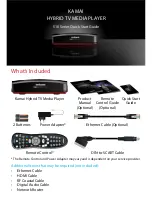
AC7A/B User’s Guide
27
ADDITIONAL TECHNICAL INFORMATION
GENERAL NOTES
a.
The communication LEDs are labeled with respect to the RS-422/485 side of the AC7A/B.
The TX (Transmit) LED will flash when the AC7A/B is transmitting data through its RS-422/485 port
(i.e., data is entering the RS-232 port and exiting the RS-422/485 port).
TX = RS-232 —> AC7A/B —> RS-422/485
The RX (Receive) LED will flash when the AC7A/B is receiving data into its RS-422/485 port (i.e., data is
entering the RS-485 port and exiting the RS-232 port).
RX = RS-232 <— AC7A/B <— RS-422/485
The RTS (Request to Send) LED will turn on when the AC7A/B is requesting to transmit data out its
RS-422/485 port. The RTS output tells the other RS-422/485 device that the AC7A/B would like to
send data.
RTS = AC7A/B —> RS-422/485
The CTS (Clear to Send) LED will turn on when the AC7A/B is receiving a CTS signal from another
RS-422/485 device. The received CTS signal tells the AC7A/B that the other RS-422/485 device is ready
to receive data. In other words, the received CTS signal gives the AC7A/B permission to transmit data out
of its RS-422/485 port.
CTS = AC7A/B <— RS-422/485
b.
TO± and RTS± are outputs from the AC7A/B.
c.
FO± and CTS± are inputs into the AC7A/B.
d.
TO and FO are used for data. RTS and CTS are used for handshaking.
e.
Logic GND is an electrical reference point. While not absolutely essential, it is used to connect the DC
common of the AC7A/B power supply to the DC common of the other device’s power supply. This is used
to equalize (voltage) differences between the two devices when each device has an isolated floating
power supply.
ADDITIONAL TECHNICAL INFORMATION














































